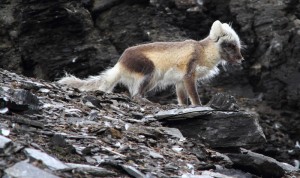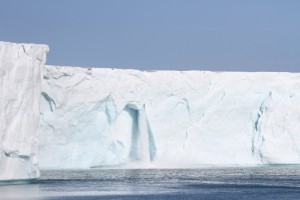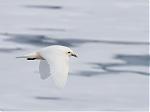
I wrote this condensed version of a trip report to Svalbard from the 26 pages of text and photos David Blair of the UK sent me. Thank you very much, David.
The trip is a 12-day circumnavigation of the Svalbard island group. Svalbard is located north of Norway, between Norway and Greenland and about midway between Norway and the North Pole. Politically, the islands are an integral part of Norway.
David took two Canon cameras, the 50d and the 7d and a Sigma 150 to 500 mm lens.
Before going on this trip, David and Sarah had to decide whether to go to Svalbard or Churchill in Canada to see Polar Bears. At Churchill, you are guaranteed to see bears; at Svalbard, you will probably see them, but there is no guarantee. At Churchill, you will tour by bus and see the bears walking around on the shore. At Svalbard, you can see the bears in their natural environment on ice flows, swimming and hunting seals. Going to Churchill is cheaper than going to Svalbard. They opted for the Svalbard tour. His trip went from 8 to 21 July.
Days one and two – They set sail into the land of Svalbard Polar Bears
First, get yourself to Longyearbyen, Svalbard Islands, Norway. You will have to fly into Oslo and then change planes. Longyearbyen is the largest town and administrative centre of the Svalbard Islands. SAS and Norwegian Airlines have daily flights to Longyearbyen. You will probably stay one night at a Longyearbyen hotel and board your ship the following day.
So, day one was spent getting to Longyearbyen. On day two, David and Sarah had time to do some exploring. Just outside of town, civilisation ends, and you enter “Polar Bear Territory.” They were told not to go out of town without an armed guide, as polar bears are in the vicinity. They strolled along the main road, walking up past the reservoir and the husky dog stations.
Take a walk from town to the bird hide at the reservoir, and you might see the following birds: Arctic Terns, Arctic Skua, Purple Sandpipers, Dunlin, Pectoral Sandpiper, Ringed Plover, Common Eider, Barnacle Geese, Snow Buntings, and Glaucous Gull.
On the evening of day two, David, Sara and 101 other passengers boarded the MS Expedition to circumnavigate the Svalbard Islands. “We looked for a trip that tried to go around the archipelago on a smallish ship, as we thought getting into the pack ice offered a better chance of bears at work and play. So it was we booked with Gadventures, booking nearly a year in advance got us a 15% discount and a cabin upgrade on the 4th Deck with a Picture window.”
David and Sarah spoke to some people who had been on the previous trip, and they said that they had seen only one bear.
They set sail at 6 pm and spent the evening enjoying the scenery and the Northern Fulmars that were flying around in abundance.
Day three, after the first night on board the ship
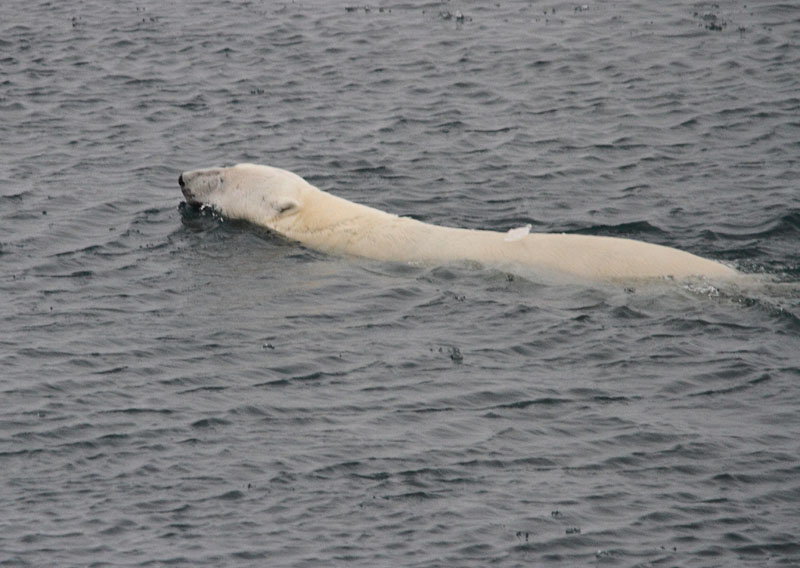

On the first morning, naturalists on board will give a lecture on the wildlife of the islands. After the wildlife lecture, the first bear was sighted about 150 yards (137 metres) in front of the ship. They watched him swim for about 20 minutes before he reached land and disappeared.
Depending on conditions, the ship might land at the community of Hornsund, where you can see a colony of Little Auks and the possibility of Arctic Foxes. On David’s trip, they were not able to land as the dock was full (It has a maximum capacity of only two ships).
Later in the day, David and Sarah saw two humpback whales and a pod of rare White-beaked Dolphins.
Day four, the first Arctic Fox
The next landing place was Kapp Lee, where Walrus sightings are possible, but again, they could not land; this time due to high winds.
The passengers finally got ashore at Sundneset on Barentsoya Island. Travel between ship and shore is by Zodiac, a large rubber boat with an outboard motor. On the way to shore, king eiders were spotted.
Later in the day, they landed again at Diskobukta, where three Arctic Foxes were sighted. They are not white at this time of year, and David describes them as scruffy-looking. Arctic Foxes are white in the winter but turn a brownish silver colour in summer.
David estimated that some 80,000 Black-legged Kittiwakes, Snow Buntings, Pink-footed Geese, Red-throated Loons (aka Divers), and Black Guillemots were sighted on the island.
Day five, at the Negreibreen Glacier, 6 degrees C
Blue sky and sunshine made for an impressive view of the Negreibreen Glacier. “As we got within about 300 metres there was a massive calving which sent substantial waves towards the ship, but we need not have worried (actually I don’t think anyone else did as they carried on taking photos or video while the wave approached us, and all we got was a gentle shaking.” There were huge numbers of kittiwakes and fulmars. Scouts went out to check landing possibilities. Passengers were supposed to land at a small island in Heleysundet channel, but could not because there was a bear on the island. Instead, they travelled through the channel alongside the ship on the zodiacs.
They saw Red Phalarope, Barnacle Geese, Glaucous Gulls, Black Guillemots and spectacular scenery. The ship docked for the night at Torellneset.
Day six, the Island of Torellneset, 12 degrees C.

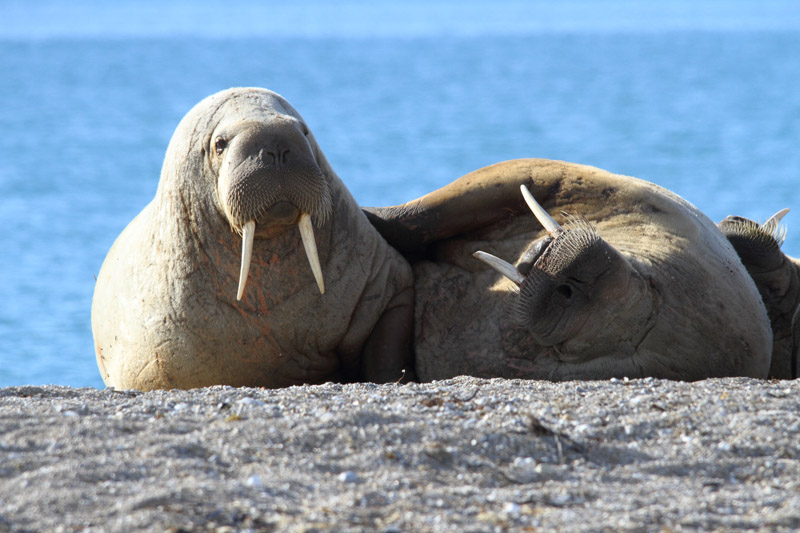
“Fortunately, the wind was OK for zodiacs and there were no bears seen within the perimeter, so after breakfast we went ashore, where 12 walrus were waiting for us. The expedition guides roped off an area about 30 yards (27.4 metres) from the walrus, where we could view them without disturbing them.” Birds seen included Brunnich’s Guillemots, Snow Buntings, Purple Sandpiper, Arctic Tern, Arctic Skua and Long-tailed Skua.
Back on the ship, they moved on to Brasvellbreen, the largest glacier in the northern hemisphere at 170 km (105.6 miles) across and 250 (155 miles) deep. While it appears to float, it is actually resting on ground below sea level.
Here, on a Zodiac trip, they sighted Bearded and Ringed Seals. Later, from the ship, they sighted an Ivory Gull. The Ivory Gull is the only pure white gull. They are seldom seen as they live only in the high Arctic along the north coast of Greenland and islands in northern Canada, Russia, and if you are lucky, a few other places such as Svalbard.
Part Two
The best polar bear sightings and photographs are yet to come in Part Two of this amazing 12-day Arctic trip. All photographs courtesy of David and Sarah Blair. Click Here.
